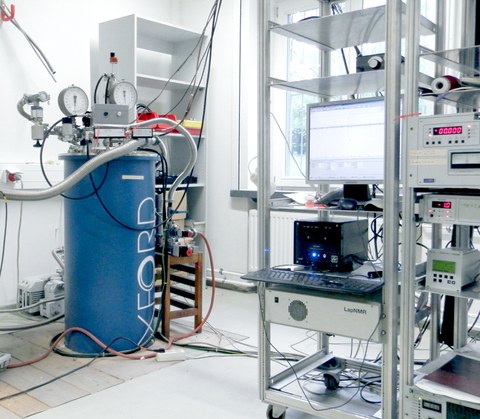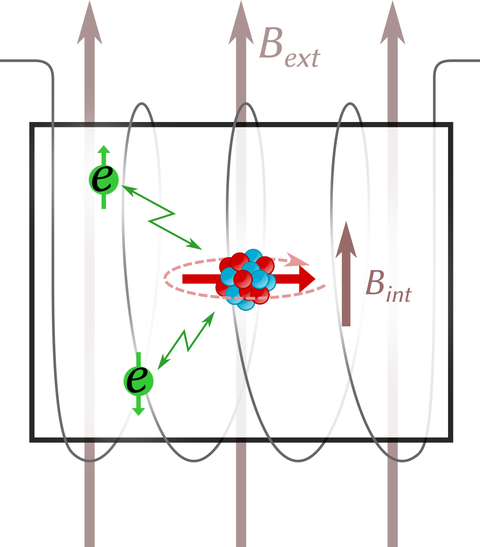Nuclear magnetic resonance (NMR)
Table of contents
Description
Nuclear magnetic resonance (NMR) is a method of local probes. It allows us to observe magnetic (and electric) fields in a solid state or liquid sample directly at the nucleus site with high precision. In chemistry or medicine, NMR is very popular. But nevertheless, it is very applicable in solid state physics as well. A lot of microscopic information about dia-/paramagnetism, magnetic ordering, superconductivity et cetera can be accessed. Furthermore, we can draw conclusions about dynamic properties of correlated electron systems, such as magnetic (spin-)fluctuations.
A wealth of interesting systems in solid state physics can be investigated with NMR, including frustrated magnetism, low-dimensional spin systems, molecular magnets, exotic highly correlated metals like heavy-fermions, unconventional superconductors and others.
In most cases, an external magnetic field is applied to perform NMR. At the IFP, two superconducting magnets with fields up to 15 T are available for the NMR group. In addition to that, our scientists perform NMR in even higher fields in specialized high magnetic field laboratories (NHMFL, EMFL).

NMR lab
Physical Background
Many nuclides exhibit a non-zero angular momentum I (=nuclear spin). These nuclei have 2I+1 possible states whose degeneration is lifted by the Zeeman-effect in magnetic fields and the electric field gradient. Analogously to atoms in lasers, nuclei can be excited with irradiated photons in the radio frequency (RF) regime. After resonant excitation in well defined RF-pulses, the nuclear spins follow a precession motion, giving rise to a rapidly rotating magnetization. Eventually, this magnetization can be measured by induction in a coil. The frequency spectrum, where the resonance condition is fulfilled, is a measure of the local static magnetic field and further the electric field gradient at the nucleus site. After pulsing, nuclear spins are far from thermal equilibrium. The relaxation process back to the equilibrium state is described by two characteristic times: T1 and T2. They contain valuable information about the dynamic interactions of electrons to each other.

NMR excitation
Equipment
-
2-channel 750 MHz spectrometer Tecmag Apollo
-
125 MHz spectrometer Tecmag LapNMR
-
superconducting magnet 8T (variable) with bath cryostat
-
superconducting Magnet 15T (variable) with bath cryostat
-
probes for frequencies 500 kHz to 750 MHz
-
4He continuous-flow inset cryostats (down to 1.4 K)
-
4He continuous-flow cryostat (down to 4.2 K)
-
under construction: 3He-4He dilution fridge (down to 50 mK)
